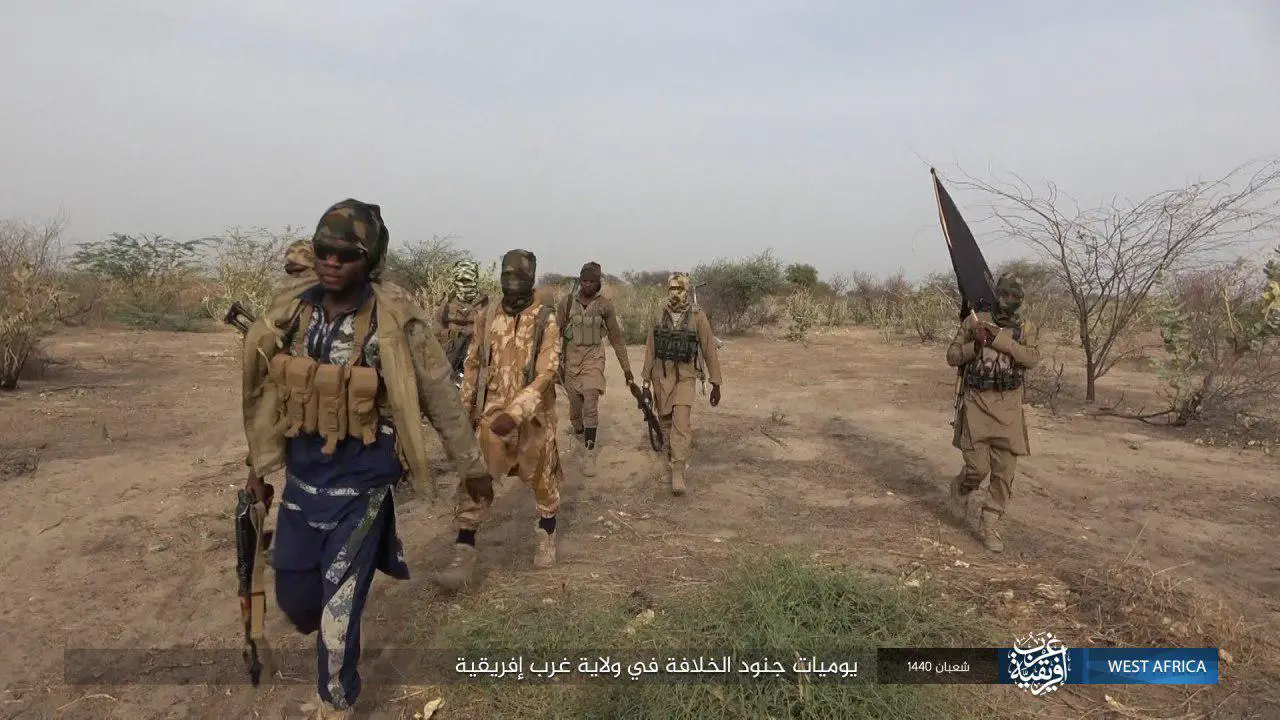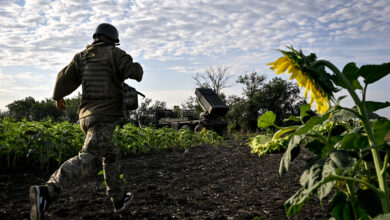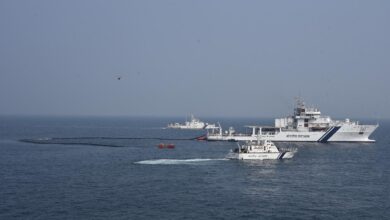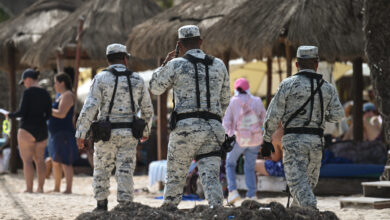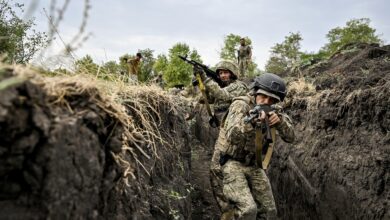Fighters from Islamic State West Africa Province killed at least six soldiers and a civilian militia leader when they attacked four towns in Nigeria’s northeastern Borno state, security sources and residents said on Friday.
Several troops and militiamen are also missing, they said.
ISWAP fighters attacked the town of Gubio around 1630 GMT on Thursday, September 12.
“The bodies of six soldiers and the [local] head of the Civilian Joint Task Force were recovered outside the town with bullet wounds,” a security source said.
The fighters stormed into Gubio aboard a dozen pickup trucks mounted with machine guns, according to local resident Idrissa Kaka, who confirmed the death toll.
They also made off with three military vehicles and a van belonging to the CJTF, a militia that battles Boko Haram and ISWAP alongside the military.
“The whereabouts of the remaining soldiers is unknown. Our fear is that they were captured along with the vehicles,” he said.
The CJTF member killed was named on social media as Bulama Bukar, known as Maradona, who was the leader of the CJTF in the Local Government Area.
Insurgents also attacked the towns of Gajigana and Gajiram, where they torched buildings and sent soldiers fleeing, residents said. There were also reports of an attack on Magumeri.
The towns are relatively close together: Gubio is around 80 km (50 miles) north of Borno state capital Maiduguri; Gajiram lies around 45 km east, Gajigana (also spelled Gajiganna) is around 28 km south of Gajiram, and Magumeri is around 34 km southwest of Gajigana, on the road between Maiduguri and Gubio.
A security source told Daily Trust that that Gajigana was attacked by fighters in around a dozen vehicles at 5:30 p.m.
Citing residents, Daily Post reported that the four towns were attacked simultaneously at that time.
“They were telling people that, they were not attacking civilians, however, they burnt some properties in Gubio,” Gubio resident Abubakar Ahmed told the paper. “Some people said they took away vehicles belonging to security forces and killed some.”
In a statement, ISIS claimed five soldiers were killed when ISWAP fighters ambushed a military convoy between Gubio and Maiduguri on Thursday, and that three four-wheel-drive vehicles were captured.
The statement also claimed two Nigerian soldiers were killed and others injured in a Thursday attack on a military base in Gajigana. An unspecified number of four-wheel-drive vehicles were captured and “armor” burned, it said.
The attacks came a day after Borno state governor Babagana Umara Zulum visited Gajigana, presenting a patrol vehicle to the CJTF and ordering monthly payments for 112 hunters and the CJTF.

Repeated attacks in the area
All four towns have been repeatedly targeted by ISWAP.
On September 4, ISWAP fighters killed at least three Nigerian soldiers and a police officer in attacks in Gajiram. ISIS claimed 10 soldiers were killed and others were injured.
That came just days after at least three Nigerian soldiers were killed in an ISWAP ambush between Gajiram and Monguno on August 30. Two military sources told AFP that eight troops were killed, but the Nigerian Army later said that only three were killed and eight others injured. ISIS propaganda agency Amaq later released a video that it said showed the ambush.
In an incident attributed to “Boko Haram,” four people were killed and 21 women were abducted when militants attacked Gajiram on August 25, Daily Trust reported.
On August 10, ISWAP fighters attacked a Nigerian Army base at Gubio killing three soldiers and three civilians. ISIS propaganda agency Amaq later published a series of images that it said were from an attack in Borno state.
On July 8, 13 civilians were reportedly killed in an airstrike as the Nigerian military repelled an apparent ISWAP attack on Gajigana. The Nigerian Air Force later said it had no reports of civilian casualties.
Earlier in the year, military bases in Gajiram, Kareto, Gubio, Gajigana and Magumeri were attacked.

Ambushes: an increasingly common tactic
Thursday’s attacks bear a striking similarity to incidents earlier in the week. On Monday, Nigerian soldiers were killed in an ambush on a military convoy near Gudumbali, around 65 km northeast of Gubio. ISIS claimed ISWAP fighters ambushed the convoy between Damasak and Gudumbali, and struck another military position near the village of Garunda, about 20 km west. Amaq later released a video that it said showed the ambush. The Nigerian Air Force on Wednesday released video of airstrikes on what it said were ISWAP vehicles near Garunda the previous day.
ISWAP began to intensify attacks on Nigerian military targets in July 2018, killing dozens of soldiers, overrunning bases and capturing towns. The Lake Chad area of Nigeria, Chad and Niger, where it is the dominant insurgent group, has seen particularly fierce fighting, but it has also claimed or been blamed for attacks in the Maduguri area and further west.
In late December 2018, ISWAP fighters overran military and naval bases in and around the town, which is on the shores of Lake Chad, around 130 km northeast of Gubio. One base that housed MNJTF troops was recaptured weeks later, but Baga itself and a separate naval base on Lake Chad remained under ISWAP control in August, according to AFP sources.
Late July saw the deadliest incident in recent months, when 25 Nigerian and Chadian soldiers were killed in clashes with ISWAP fighters near Baga that left at least 40 insurgents dead, AFP reported.
ISWAP fighters have continued to attack troops in the wider area, and ambushes have become more frequently employed tactic, perhaps as roadside vegetation has grown during the rainy season, offering cover for attacks on vehicles.
The Nigerian Army has also adopted a strategy under which military personnel have withdrawn from smaller bases in towns and villages, concentrating forces in “super camps” which are more-easily defended from ISWAP attacks.
The concentration of forces enables mobile counter-insurgency raids, but those military movements themselves present ambush opportunities for ISWAP.
The drawbacks of the “super camp” strategy became apparent on August 21, when ISWAP fighters reportedly entered Gubio and Magumeri unopposed, taking control of both towns and burning government buildings.
Borno state governor Babagana Zulum later expressed concern about the strategy, warning that “the absence of the Nigerian military in a particular place will create a vacuum” that insurgents could exploit.

A decade of Islamist insurgency
The jihadist group known as Boko Haram began its bloody insurgency in northeastern Nigeria in 2009, but it has since spread into neighboring Niger, Chad and Cameroon, prompting a regional military response.
Boko Haram split into two factions in mid-2016. One, led by long-time leader Abubakar Shekau, is notorious for suicide bombings and indiscriminate killings of civilians. Shekau pledged allegiance to ISIS leader Abu Bakr Al-Baghdadi in March 2015, but ISIS central only gives formal backing to the other faction, which it calls Islamic State West Africa Province.
The ISWAP faction, which largely focuses on attacking military and government targets, was led by Abu Mus’ab Al-Barnawi, but in March, audio recordings revealed that ISIS appointed Abu Abdullah Idris bin Umar, also known as Ibn Umar al-Barnawi and Ba Idrisa, as leader. Despite releasing several videos featuring ISWAP since, ISIS has not yet made a public statement confirming the change.
On September 10, the United States added Ba Idrisa to its Specially Designated Global Terrorist list. The U.S. Treasury Department sanctions listing named him as Abu Abdullah Idris bin Umar Al-Barnawi and “Ba Idrisa” and said that he was born in Maiduguri between 1989 and 1994. The listing did not specify which faction he belongs to.
The U.S. assesses that Boko Haram and ISWAP have been responsible for more than 35,000 deaths since 2011. More than two million people have been displaced, sparking a dire humanitarian crisis in the region.
The regional Multinational Joint Task Force, which comprises personnel from Chad, Cameroon, Niger, and Nigeria, launched Operation Yancin Tafki on February 21 to battle the insurgents. It has said the cross-border operation is aimed at “making islands and other settlements in Lake Chad untenable for Boko Haram Terrorists.” MNJTF troops have engaged militants in Nigeria, Niger and Chad.
With reporting from AFP

